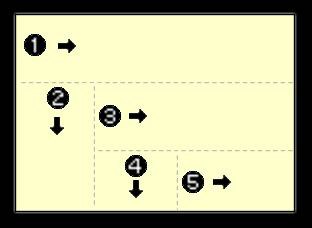Moistening Paper - further considerations (entry by David Bull)
It takes quite a bit of practice to get printing paper moistened evenly. As the brush is full at the beginning of each stroke, but gradually loses water as it moves across the paper, the tendency is for one end of the sheets to become somewhat wetter than the other end. There are a couple of ways to guard against this. The easiest is simply to flip alternate sheets around so that the moisture is in approximate balance throughout the stack.
Another way is to adjust the speed of the brush stroke, starting out quite quickly, but then slowing down as you reach the opposite end of the paper. The moisture thus released is approximately equal.
Professional printers here in Japan generally use the stroke order shown in this illustration. They don't flip the paper around at all, but equalize moisture by varying the speed of their strokes.

Stroke (1) is 'back-hand'. Stroke (2) then follows naturally - 'front-hand'. (3) and (4) follow the same pattern - back and forward, and stroke (5) finishes off. (This illustration is for right-handed people; I do it the other way around myself ...)
Of course, the number of strokes you will make depends on the relative sizes of your brush and the paper.
It is possible to 'tint' the paper at the same time that the moistening is being done, by mixing the desired pigment with the water. In that case, you have to be very careful to ensure that your brush strokes neither overlap a great deal, nor leave wide gaps between ...
This is most effective when done with a dull sandy colour, giving an 'aged' feeling to the finished print.
(David Bull)